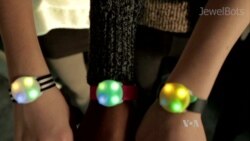Social networks are a big part of our lives, but opinions diverge when it comes to how effective they are in fostering interpersonal relationships. A few tech startups, however, have devised new ways to help us improve our face-to-face-communications.
At the recent Social Media Week conference in New York City, tech executives took to the stage to show off their latest innovations, many of which were less about the technologies themselves and more about the humans they were designed to connect.
Scott Davison, vice president of hardware engineering at Jewelbots, explained how getting young girls interested in coding is easy when you speak their language - not Java or C++ - but the language of jewelry.
“It’s something that girls like, and something that girls would use and want to make their own,” said Davison.
Jewelbots are friendship bracelets that light up with custom patterns girls can program themselves. The bracelets provide various notifications, lighting up when other friends are nearby or when users have new followers on social media. Think of them as the kid-friendly version of the Apple watch.
“We’re pitching it as a wearable and targeting a market that is usually avoided by just about everybody else,” said Davison.
Senior caretakers
Another market overlooked by technology startups? Seniors and the elderly. Josh Bruno of Hometeam experienced it firsthand when trying to find in-home care for his grandfather.
“This is something that just comes out of nowhere for a lot of people . . . it could happen after a hospitalization, maybe a hip fracture,” said Bruno. “Suddenly, you need a little extra help in the home, but you’re not ready for a nursing home yet,” he added.
Bruno’s startup helps families navigate caretaking decisions for their loved ones, and pairs home health aides with seniors who wish to stay in their homes. Ipads are placed within each home and family members are kept in the loop via the HomeTeam app.
“The caregiver is checking in with you over the application or by phone, whatever you prefer. So, this is pictures throughout the day, checking off specific tasks set forth by the doctor and you...you’re getting an email or an update every single day, often in real-time," Bruno explained.
Watching sports together virtually
That tech-meets-human approach can also bridge physical and digital divides for sports fans.
Andre Lorenceau, founder and CEO of virtual reality company LiveLike, wanted to watch his beloved college football games with his friends. The problem, though, was that everyone was spread across the globe. Lorenceau started LiveLike, a virtual reality club room in which to watch live games while simultaneously interacting with friends.
“You’ll feel like you’re at the stadium, and you can switch seats at will and you can talk to your friends no matter where they actually are,” said Lorenceau.
The startup is working to secure partnerships with major sports broadcasting networks to implement their software into branded, virtual reality apps.
As these startups prove, new technologies continue to provide new means of communication, but the personal connections they foster are still very much human.








